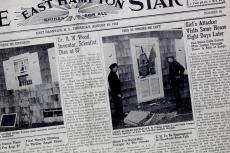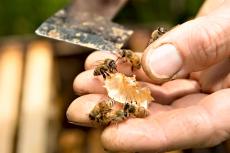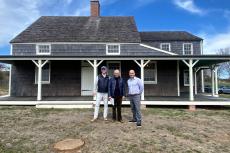Three and a half years after he first brought up the idea to the East Hampton Town Trustees, John Nicholas, an owner of the East Hampton Oyster Company and of Sunset Cove Marina, on Folkstone Creek off Three Mile Harbor in Springs, was granted permission to convert a portion of the marina to an oyster nursery.
The trustees are stewards of most underwater land in the town outside of Montauk. Mr. Nicholas went to the trustees in March 2019, needing their approval as well as that of the New York State Department of Environmental Conservation, the town’s Building Department, and the zoning and planning boards. He also needed a natural resources special permit. With the latter permit received on Nov. 1, he had all permits in place except the trustees’.
The plan calls for five floating upweller systems, known as flupsys, 18 floating raft cages, and 200 lantern nets. “Our proposed oyster business will be within the footprint of the current marina space,” Mr. Nicholas told the trustees on Monday, “and not interfere with any navigation in any way. We believe the addition of oysters will greatly enhance the water quality, and potentially spur the return of natural oyster growth in the northern end of Three Mile Harbor.”
Oysters are filter-feeding organisms. Rates of oyster filtering are said to range from 30 to 50 gallons per day per oyster.
When the proposal was first presented to them, the trustees voiced concerns about the creek’s “carrying capacity” — whether there are sufficient nutrients in the water for the volume of oysters to grow — and the potential to introduce disease. But they had warmed to the idea when Mr. Nicholas returned to them a year ago, commending him for transferring marina slips used for recreational purposes to an environmentally beneficial purpose.
To assuage the trustees’ concerns, Mr. Nicholas said he had submitted a proposed five-year study to be conducted by Christopher Gobler of Stony Brook University’s School of Marine and Atmospheric Sciences “to monitor the water and the coastal rehabilitation of the property as it changes from marina to an oyster farm.” The proposed study would cost $100,000 over five years, he said. “I request that you grant us the opportunity to operate the oyster farm now under the same guidelines as the D.E.C., and allow me time to apply for grants to cover the coastal rehabilitation study.”
Mr. Nicholas, said John Aldred of the trustees, who is a former director of the town’s shellfish hatchery, “has been very cooperative about putting a monitoring plan together for this operation.” Because the plan calls for “very intensive culture in a relatively small creek which dead-ends in the Folkstone area, there is some concern about possible dissolved oxygen levels going low, given the concentration of biomass in the farm and the nature of the algal makeup.”
Mr. Nicholas plans to start buying oyster spat now, he said, in order to begin operation in the spring. The monitoring study “has a before, during, and after component,” Mr. Aldred said, “so I think it’s important to get some information up front so we know what the conditions are before any activity begins in the farm.”
All of the seven trustees present voted to approve the permit. “I would encourage John to come back to this board if he is seeking grant funds to do this,” Mr. Aldred said, “and see how the board feels about contributing to this monitoring work.”
Mr. Nicholas is a partner in oyster growing sites in Gardiner’s and Napeague Bays under the Suffolk County Aquaculture Lease Program. His plan is to transfer juvenile oysters from the marina site to the leased sites for further growth, he told the trustees last year. “I love oysters more than the boats,” he said on Monday, admitting that such a statement “sounds strange for a marina owner to say.”



